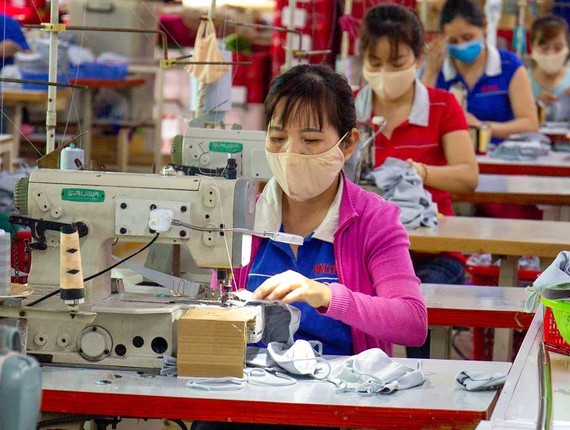 Garment production for export at Kim Dung Textile and Garment Company in District 12, Ho Chi Minh City. (Photo: SGGP)
Garment production for export at Kim Dung Textile and Garment Company in District 12, Ho Chi Minh City. (Photo: SGGP)
Dependence on imported raw materials Ms. Nguyen Thi Tuyet Mai, Deputy General Secretary of the Vietnam Textile and Apparel Association, said that the total number of enterprises participating in the textile and garment sector in Vietnam, including foreign and domestic enterprises, is more than 7,000. Of which, only 18 percent of them produce fabric materials, 12 percent produce yarn, 2 percent produce other materials, and the rest are garment enterprises. This fact has put the textile industry in front of the challenge of unstable growth due to its dependence on imported raw materials. Currently, each year, Vietnam imports 100 percent of cotton with an estimated value of US$3.2 billion and 60 percent of fabric with an estimated value of $14 billion. The US is the largest cotton and fabric import market of Vietnam, followed by China, Japan, South Korea, and Europe. In fact, in 2020 and 2021, when the Covid-19 pandemic broke out in many countries and developed complicatedly, the domestic textile and garment industry was severely affected. Many manufacturing factories had to temporarily close or go bankrupt due to supply chain disruptions, and enterprises did not have raw materials for production. Mr. Pham Xuan Hong, Chairman of the Board of Directors of Saigon No.3 Garment Joint Stock Company, said that with the current high proportion of imported materials, domestic enterprises are extremely vulnerable to fluctuations in the global market. For instance, from the beginning of the year to now, raw material prices have increased continuously and are 20-50 percent higher than the same period last year, depending on the type. In addition, the sharp increases in domestic gasoline prices have been causing many difficulties for businesses. Many garment enterprises have had to switch to receiving short-term orders instead of long-term ones or to let the price terms open. This is sue significantly reduces the competitiveness of export enterprises. According to Mr. Vu Duc Giang, Chairman of the Vietnam Textile and Apparel Association, the textile and garment export turnover is high. However, the import turnover of raw materials is also high, which has lowered Vietnam's trade surplus in the textile and garment sector. Currently, the trade surplus in the textile and garment sector fluctuates at $15 billion. Meanwhile, export turnover has reached nearly $41 billion. Vietnam's textile and garment export turnover has continuously grown at double digits in the past five years. It proves that textile and garment enterprises have made flexible changes to overcome difficulties and maintain their growth ability. Specifically, textile and garment export turnover touched $35 billion in 2020 and $40.45 billion in 2021. In the first five months of 2022, it has accelerated to $11.8 billion. However, in the long run, garment enterprises still need support from domestic production activities to increase the localization ratio of raw materials. It is considered a vital factor for textile enterprises to maintain and accelerate development, taking advantage of the opportunities brought by free trade agreements.The supply of raw materials needs to be diversified Ms. Sevil Abilova, Director of International Relations and Event Management Department at Azerbaijan Export & Investment Promotion Foundation, said that the source of raw materials for the textile and garment industry in the world is quite diverse and abundant. In the context that Vietnamese textile and garment enterprises have not gained autonomy in the supply from the domestic market, it is possible to increase the supply of raw materials from many import markets. It is a solution to avoid dependence on a few markets, which easily leads to the risk of production disruption due to supply chain disruption. Therefore, Vietnamese enterprises need to actively participate in trade promotion activities with many markets supplying textile and garment materials in the world. Vietnamese textile enterprises said that the scale of Vietnam's textile and garment export market is extremely large. It is a favorable opportunity for many foreign raw textile material manufacturers. However, enterprises need support from authorities to verify factors, such as supply capacity from partners, as well as what barriers need to be overcome to access and enter the market. Mr. Vu Duc Giang recommends that businesses need to understand order methods and payment and delivery methods from partners. At the same time, domestic enterprises need to transform production to meet the requirements of green production, sustainable development, and the implementation of a circular economy. It not only comes from the requirements of import partners and the development trend of green fashion in the world but also from the commitment of the Vietnamese Government on environmental protection on a global scale.
In the long term, enterprises recommend the Government and the Ministry of Industry and Trade strengthen investment promotion in the direction of supporting domestic enterprises to invest in producing raw materials in countries with large cotton sources in the world to increase safety and stability for the development of the textile and garment industry.
























